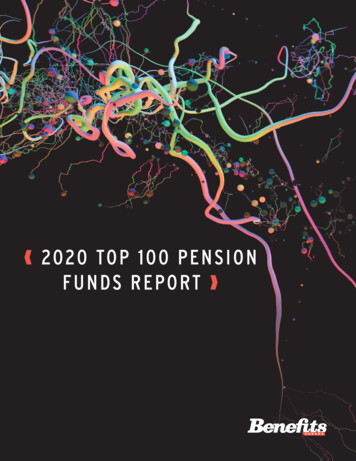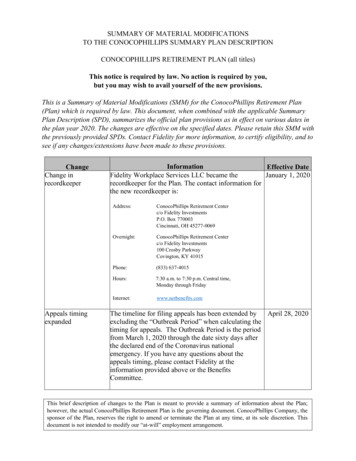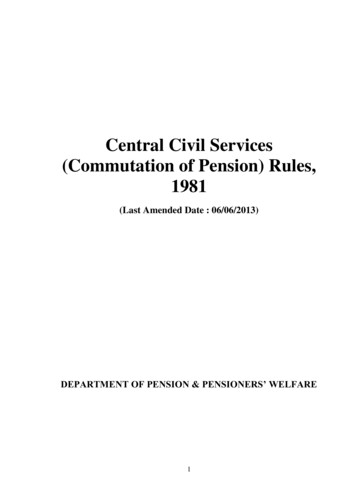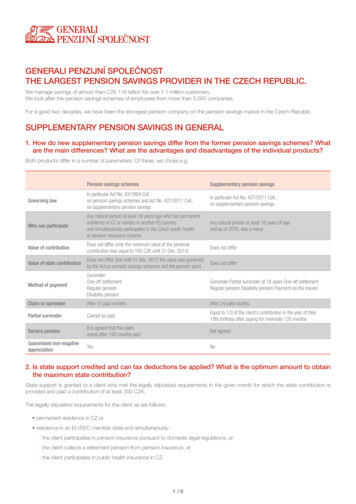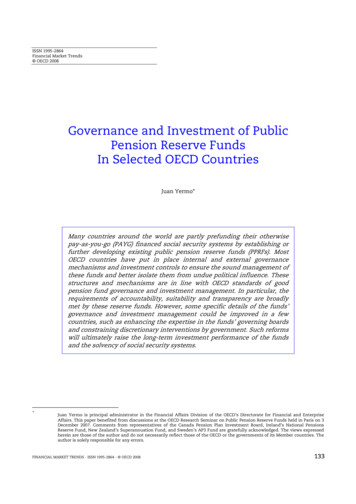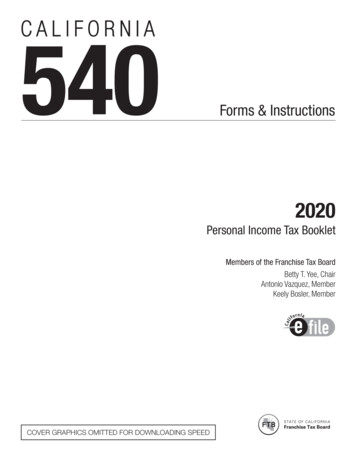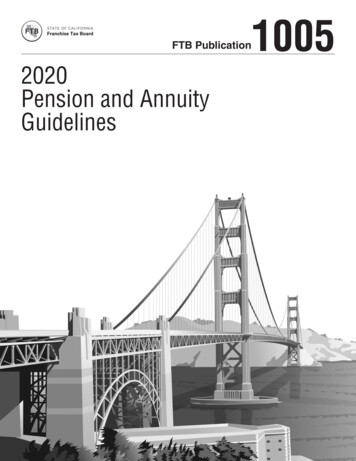
Transcription
1005FTB Publication2020Pension and AnnuityGuidelines
Table of ContentsWhat’s New . . . . . . . . . . . . . . . . . . . . . . . . . . . . . . . . . . . . . . . . . . . . . . . . . . . . . . . . . . . . . . . . . . . . . . . . . . . . . . . . . . . . . . 3General Information . . . . . . . . . . . . . . . . . . . . . . . . . . . . . . . . . . . . . . . . . . . . . . . . . . . . . . . . . . . . . . . . . . . . . . . . . . . . . . . 3Introduction . . . . . . . . . . . . . . . . . . . . . . . . . . . . . . . . . . . . . . . . . . . . . . . . . . . . . . . . . . . . . . . . . . . . . . . . . . . . . . . . . . . . . . 3Important Reminders . . . . . . . . . . . . . . . . . . . . . . . . . . . . . . . . . . . . . . . . . . . . . . . . . . . . . . . . . . . . . . . . . . . . . . . . . . . . . . 3Common Terms Used in this Publication . . . . . . . . . . . . . . . . . . . . . . . . . . . . . . . . . . . . . . . . . . . . . . . . . . . . . . . . . . . . . . . 3Figuring Your California Pension, Annuity, and IRA Amounts . . . . . . . . . . . . . . . . . . . . . . . . . . . . . . . . . . . . . . . . . . . . . . . . 4Social Security and Railroad Retirement Benefits . . . . . . . . . . . . . . . . . . . . . . . . . . . . . . . . . . . . . . . . . . . . . . . . . . . . . . . . 4Three-Year Rule . . . . . . . . . . . . . . . . . . . . . . . . . . . . . . . . . . . . . . . . . . . . . . . . . . . . . . . . . . . . . . . . . . . . . . . . . . . . . . . . . . 4California Residents Receiving an Out-of-State Pension . . . . . . . . . . . . . . . . . . . . . . . . . . . . . . . . . . . . . . . . . . . . . . . . . . . 5Nonresidents of California Receiving a California Pension . . . . . . . . . . . . . . . . . . . . . . . . . . . . . . . . . . . . . . . . . . . . . . . . . . 5Individual Retirement Arrangements (IRAs) . . . . . . . . . . . . . . . . . . . . . . . . . . . . . . . . . . . . . . . . . . . . . . . . . . . . . . . . . . . . . 5IRA Deduction . . . . . . . . . . . . . . . . . . . . . . . . . . . . . . . . . . . . . . . . . . . . . . . . . . . . . . . . . . . . . . . . . . . . . . . . . . . . . . . . . . 5IRA Distribution . . . . . . . . . . . . . . . . . . . . . . . . . . . . . . . . . . . . . . . . . . . . . . . . . . . . . . . . . . . . . . . . . . . . . . . . . . . . . . . . . 6Coverdell Education Savings Accounts (ESAs). . . . . . . . . . . . . . . . . . . . . . . . . . . . . . . . . . . . . . . . . . . . . . . . . . . . . . . . . 10Archer Medical Savings Accounts (MSAs) . . . . . . . . . . . . . . . . . . . . . . . . . . . . . . . . . . . . . . . . . . . . . . . . . . . . . . . . . . . . 10Health Savings Accounts (HSAs) . . . . . . . . . . . . . . . . . . . . . . . . . . . . . . . . . . . . . . . . . . . . . . . . . . . . . . . . . . . . . . . . . . . 10California Achieving a Better Life Experience (ABLE) Accounts . . . . . . . . . . . . . . . . . . . . . . . . . . . . . . . . . . . . . . . . . . . . 10Roth IRA . . . . . . . . . . . . . . . . . . . . . . . . . . . . . . . . . . . . . . . . . . . . . . . . . . . . . . . . . . . . . . . . . . . . . . . . . . . . . . . . . . . . . 10Roth IRA Worksheet . . . . . . . . . . . . . . . . . . . . . . . . . . . . . . . . . . . . . . . . . . . . . . . . . . . . . . . . . . . . . . . . . . . . . . . . . . . . 11Simplified Employee Pension (SEP) . . . . . . . . . . . . . . . . . . . . . . . . . . . . . . . . . . . . . . . . . . . . . . . . . . . . . . . . . . . . . . . . . . . 12Self-Employed Retirement Plans (Keoghs) . . . . . . . . . . . . . . . . . . . . . . . . . . . . . . . . . . . . . . . . . . . . . . . . . . . . . . . . . . . . . 12Lump-Sum Distribution . . . . . . . . . . . . . . . . . . . . . . . . . . . . . . . . . . . . . . . . . . . . . . . . . . . . . . . . . . . . . . . . . . . . . . . . . . . . . 13Change in Residency . . . . . . . . . . . . . . . . . . . . . . . . . . . . . . . . . . . . . . . . . . . . . . . . . . . . . . . . . . . . . . . . . . . . . . . . . . . . . . 13Tax on Early Distributions . . . . . . . . . . . . . . . . . . . . . . . . . . . . . . . . . . . . . . . . . . . . . . . . . . . . . . . . . . . . . . . . . . . . . . . . . . . 13Basis Worksheets . . . . . . . . . . . . . . . . . . . . . . . . . . . . . . . . . . . . . . . . . . . . . . . . . . . . . . . . . . . . . . . . . . . . . . . . . . . . . . . . . 14Additional Information . . . . . . . . . . . . . . . . . . . . . . . . . . . . . . . . . . . . . . . . . . . . . . . . . . . . . . . . . . . . . . . . . . . . . . . . . . . . . . 15General Phone Service . . . . . . . . . . . . . . . . . . . . . . . . . . . . . . . . . . . . . . . . . . . . . . . . . . . . . . . . . . . . . . . . . . . . . . . . . . . . 15Go to ftb.ca.gov for:ONLINESERVICES MyFTB – view payments,balance due, and withholdinginformation. Web Pay – pay income taxes.Choose your payment date up toone year in advance. CalFile – e-file your personalincome tax return.Page 2 FTB Pub. 1005 2020 Refund Status – find out whenwe authorized your refund. Installment Agreement –request to make monthlypayments. Subscription Services – sign upto receive emails on a variety oftax topics. Tax forms and publications. FTB legal notices, rulings, andregulations. FTB’s analysis of pendinglegislation. Internal procedure manuals tolearn how we administer law.
2020 Pension and Annuity GuidelinesWhat’s NewSetting Every Community Up for Retirement Enhancement(SECURE) Act – The federal SECURE Act was enacted onDecember 20, 2019. In general, California Revenue andTaxation Code (R&TC) does not conform to the changes.California taxpayers continue to follow the Internal RevenueCode (IRC) as of the specified date of January 1, 2015, withmodifications. California law conforms to the following federalprovisions under the SECURE Act: Increase in age for required minimum distribution from 70½to 72. Withdrawal of up to 5,000 penalty-free from the retirementplan upon the birth or adoption of a child. Waives the early withdrawal penalty for qualified disasterdistributions up to 100,000 from qualified retirementaccounts (IRC Section 72(t)).California law does not conform to the following federalprovisions under the SECURE Act: Repeal of maximum age of 70½ for traditional individualretirement arrangement (IRA) contributions. Expansion of IRC Section 529 qualified tuition programaccounts to cover costs associated with registeredapprenticeship and qualified education loan repayments. Increase credit limitation for small employer pension planstartup costs.The above lists are not intended to be all-inclusive of the federaland state conformities and differences. For more information,refer to the R&TC.Coronavirus Aid, Relief, and Economic Security (CARES)Act – The federal CARES Act was enacted on March 27, 2020.In general, California R&TC does not conform to the changes.California taxpayers continue to follow the IRC as of thespecified date of January 1, 2015, with modifications. Californialaw conforms to the following federal provisions under theCARES Act: Waives the early withdrawal penalty for distributions up to 100,000 from qualified retirement accounts for coronavirusrelated purposes made on or after January 1, 2020, andbefore December 31, 2020. Waiver of required minimum distribution rules for certaindefined contribution retirement plans and IRAs for calendaryear 2020 due to COVID-19. Temporarily increases the amount of loans allowable from aqualified employer plan to 100,000 for coronavirus-relatedrelief and delays by one year the due date for any repaymentfor an outstanding loan from a qualified employer plan ifrequirements are met.California law does not conform to the following federalprovision under the CARES Act: Exclusion for certain employer payments of student loans.The above lists are not intended to be all-inclusive of the federaland state conformities and differences. For more information,refer to the R&TC.General InformationCalifornia law conforms to certain provisions of the IRCrelated to pension plans and deferred compensation, includingamendments to the IRC that may be enacted in the future.Retirement IncomeFederal law prohibits states from taxing the retirement income ofnonresidents. It also includes a prohibition on taxing retirementincome paid by a partnership to a nonresident retired partnerunder any written plan, program, or arrangement in effectimmediately before retirement begins. California does notimpose tax on retirement income received by a nonresidentafter December 31, 1995. This includes military pensions,Individual Retirement Arrangement (IRA) distributions, RothIRA conversions, Roth IRA distributions, Simplified EmployeePension (SEP), and Self-Employed Retirement Plans (Keoghs).IntroductionThis publication provides information on the California taxtreatment of the distributions you receive from your pensionplans, annuity plans, or IRAs, and how to report these amountson your California income tax return.The California treatment of pensions, annuities, and IRAs isgenerally the same as the federal treatment of such income.However, there are some differences between California andfederal law that may cause the amount of your Californiadistribution income to be different than the amount reported forfederal purposes. This publication identifies the most commondifferences and explains how to report these differences on your California tax return.Important RemindersCalifornia generally conforms to federal law. The Californiatreatment of pension and annuity income is generally the sameas the federal treatment. For example, California and federal laware the same regarding: The “General Rule.” The “Simplified General Rule” (sometimes called the “SafeHarbor Method”). IRA Rollovers. Roth IRAs. Archer Medical Savings Accounts (MSAs). Coverdell Education Savings Accounts (ESAs). Current-year IRA deductions. Lump-sum credit received by federal employees. California Achieving a Better Life Experience Accounts.Differences between California and federal law. There aredifferences between California and federal law for: Social security and railroad retirement benefits. Retirees using the “Three-Year Rule” whose annuity date wasafter July 1, 1986, and before January 1, 1987. Some prior-year IRA deductions. Health Savings Accounts (HSAs).Pensions invested in U.S. Government Securities. If yourpension plan invested in U.S. Government securities or inmutual funds that invested in U.S. Government securities, youmay not reduce the taxable portion of your pension distributionby the amount of interest attributable to the U.S. Governmentsecurities.Common Terms Used in thisPublicationAGICalifornia AdjustmentAdjusted Gross IncomeAn adjustment to your federaladjusted gross income (an additionor subtraction) to arrive at yourCalifornia AGIFTB Pub. 1005 2020 Page 3
Form 540Form 540NRSchedule CA (540)Schedule CA (540NR)Traditional IRACalifornia Resident Income TaxReturnCalifornia Nonresident or Part-YearResident Income Tax ReturnCalifornia Adjustments — ResidentsCalifornia Adjustments —Nonresidents or Part-Year ResidentsA traditional IRA is any IRA that isnot a Roth IRA or SIMPLE IRAFiguring Your CaliforniaPension, Annuity, and IRAAmountsComplete your federal tax return before starting your Californiatax return. If you need information on how to report yourpension, annuity, or IRA income on your federal tax return, referto federal forms, instructions, and publications.Once you have completed your federal tax return, compute theCalifornia amounts of your pension, annuity, or IRA income. Ifthe California amount is different than the federal amount, youwill need to make a California adjustment.* Depending on theCalifornia form you file, report your California adjustment on oneof the following forms: Schedule CA (540) for Form 540 filers. Schedule CA (540NR) for Form 540NR filers.*A California adjustment is an addition to or subtraction fromyour federal AGI. Your federal pension, annuity, or IRA income isincluded in the federal AGI figure that you list on your Californiatax return (Form 540 or 540NR, line 13).Maximum Contribution Amounts to Traditional and RothIRAs. Taxpayers may contribute the following amounts to atraditional and/or Roth IRA:Age2016Under 50 5,50050 & Over 6,50020172018201920202021 5,500 6,500 5,500 6,500 6,000 7,000 6,000 7,000 6,000 7,000Maximum Contribution Amounts to 401(k), 403(b), and 457Plans. Taxpayers may contribute the following amounts to adeferred compensation plan:Age201620172018201920202021Under 50 18,000 18,000 18,500 19,000 19,500 19,50050 & Over 24,000 24,000 24,500 25,000 26,000 26,000Maximum Contribution Amounts to Savings IncentiveMatch Plan for Employees (SIMPLE). Taxpayers may contributethe following amounts to a Simple IRA and Simple 401(k):Age201620172018201920202021Under 50 12,500 12,500 12,500 13,000 13,500 13,50050 & Over 15,500 15,500 15,500 16,000 16,500 16,500Maximum Contribution Amounts to Keogh. The maximumcontribution amount a taxpayer can make to a Keogh plan peryear is as follows: 2021, the amount is 58,000 2020, the amount is 57,000 2019, the amount is 56,000 2018, the amount is 55,000 2017, the amount is 54,000 2016, the amount is 53,000Page 4FTB Pub. 1005 2020Maximum Deduction and Contribution Amounts to aSimplified Employee Pension (SEP). The maximum deductionand contribution amounts per plan year to an SEP are asfollows: 2021, the lesser of 58,000 or 25% of compensation(compensation is limited to 290,000) 2020, the lesser of 57,000 or 25% of compensation(compensation is limited to 285,000) 2019, the lesser of 56,000 or 25% of compensation(compensation is limited to 280,000) 2018, the lesser of 55,000 or 25% of compensation(compensation is limited to 275,000) 2017, the lesser of 54,000 or 25% of compensation(compensation is limited to 270,000) 2016, the lesser of 53,000 or 25% of compensation(compensation is limited to 265,000)Rollovers. Section 457 plans can be rolled over to otherqualified plans. In addition, distributions from a Section 457 plancan be used to purchase permissive service credit for otherretirement plans.A surviving spouse can roll over distributions from a deceasedspouse’s qualified retirement plan to a Section 457 plan in whichthe surviving spouse participates.Social Security and RailroadRetirement BenefitsCalifornia law differs from federal law in that California does nottax: Social security benefits. Tier 1 railroad retirement benefits. Tier 2 railroad retirement benefits reported on federalForm RRB-1099-R, Annuities or Pensions by the RailroadRetirement Board.** Sick pay benefits under the Railroad UnemploymentInsurance Act.Make an adjustment to exclude any of this income if itwas included in your federal AGI. See the instructions forSchedule CA (540), Part I or Schedule CA (540NR), Part II,Section A, lines 1, 5a, 5b, and 6b, for more information.The information listed applies only to United States socialsecurity and railroad retirement. Foreign social security istaxable by California as annuity income. A tax treaty betweenthe United States and another country which excludes theforeign social security from federal income or which treats theforeign social security as if it were United States social securitydoes not apply for California purposes.** Railroad benefits paid by individual railroads are taxable byCalifornia. These benefits are reported on federal Form 1099-R,Distributions From Pensions, Annuities, Retirement or ProfitSharing Plans, IRAs, Insurance Contracts, etc.Three-Year RuleThe “Three-Year Rule” was repealed for retirees whose annuitystarting date is after December 31, 1986. However, if yourannuity starting date was before January 1, 1987, and youelected to use the “Three-Year Rule,” continue to use thismethod.Under the “Three-Year Rule,” amounts you receive are nottaxed until your after-tax contributions are recovered. Once yourcontributions are recovered, your pension or annuity is fullytaxable.Generally, the California and federal taxable amounts arethe same. If the California and federal taxable amounts aredifferent, enter the difference on Schedule CA (540), Part I, orSchedule CA (540NR), Part II, Section A, line 5b, column C.
California Residents Receivingan Out-of-State PensionIn GeneralCalifornia residents are taxed on ALL income, includingincome from sources outside California. Therefore, a pensionattributable to services performed outside California butreceived after you became a California resident is taxable in itsentirety by California. See Examples 1 through 4.Examples:Example 1 – You worked 10 years in Texas, moved to Californiaand worked an additional 5 years for the same company. Youretired in California and began receiving your pension, which isattributable to your services performed in both California andTexas.Determination: You are a full-year resident of California. As aCalifornia resident, you are taxed on all your income, regardlessof its source. Do not make an adjustment on Schedule CA (540)to exclude any of the pension income.Example 2 – You worked in New York for 20 years. You retiredand moved permanently to California on January 1. While livingin California, you begin receiving your pension attributable to theservices performed in New York.Determination: You are a full-year resident of California. As aCalifornia resident, you are taxed on all your income, regardlessof its source. Do not make an adjustment on Schedule CA (540)to exclude any of the pension income.Example 3 – In December 2019, you retired and movedpermanently to California. Prior to your move, you elected toreceive your pension as a lump-sum distribution. Your pensionis attributable solely to services you performed in Washingtonprior to your move. You received the lump-sum distribution inFebruary 2020, after you became a California resident.Determination: You are a full-year California resident in 2020. Asa California resident, you are taxed on all income, regardless ofits source. Do not make an adjustment on Schedule CA (540) toexclude any portion of the Washington pension income.Example 4 – You worked in Georgia for 20 years. You retiredand began receiving your monthly pension on January 1, 2020,while you were still living in Georgia. Your pension is 2,000 amonth. Because you did not contribute to the plan, your pensionis fully taxable. On May 1, 2020, you moved permanently to California.Determination: You are a part-year resident of California.While you are a nonresident, only your California-sourceincome is taxable by California. While you are a resident,all of your income, regardless of its source, is taxable byCalifornia. Because your pension is attributable to servicesyou performed in Georgia, your pension has a Georgia source.None of the pension received while you were a nonresidentof California is taxable by California. However, the pensionreceived during the period that you are a California resident(May 1 through December 31) is taxable by California.Therefore, 16,000 ( 2,000 x 8 months) is the taxable portionof the pension to enter on Schedule CA (540NR), Part II,Section A, line 5b, column E. Do not make an adjustment onSchedule CA (540NR), column B, to exclude any of the Georgiapension income.Military PensionIf you are a California resident, your military pension is taxableby California, regardless of where the service was performed.Nonresidents of CaliforniaReceiving a California PensionIn GeneralCalifornia does not impose tax on retirement income receivedby a nonresident after December 31, 1995. For this purpose,retirement income means any income from any of the following: A qualified plan described in IRC Section 401. A qualified annuity plan described in IRC Section 403(a). A tax-sheltered annuity described in IRC Section 403(b). A governmental plan described in IRC Section 414(d). A deferred compensation plan maintained by a state or localgovernment or an exempt organization described in IRCSection 457. An IRA described in IRC Section 7701(a)(37), including RothIRA and SIMPLE. A simplified employee pension described in IRCSection 408(k). A trust described in IRC Section 501(c)(18). A military pension, even if the military service was performedin California. A private deferred compensation plan program orarrangement described in IRC Section 3121(v)(2)(C) only ifthe income is either of the following:1. Part of a series of substantially equal periodic payments(not less frequently than annually) made over the lifeor life expectancy of the participant or those of theparticipant and the designated beneficiary or a period ofnot less than 10 years.2. A payment received after termination of employmentunder a plan program or arrangement maintained solelyto provide retirement benefits for employees in excess ofthe limitations on contributions or benefits imposed by theIRC. Any retirement or retainer pay received by a member orformer member of a uniform service computed underChapter 71 of Title 10, United States Code.Individual RetirementArrangements (IRAs)The California treatment of IRAs is generally the same as thefederal treatment. For information on the federal treatmentof IRAs, refer to federal Publication 590-A, Contributionsto Individual Retirement Arrangements (IRAs), federalPublication 590-B, Distributions from Individual RetirementArrangements (IRAs), and federal Publication 560, RetirementPlans for Small Business (SEP, SIMPLE, and Qualified Plans).IRA DeductionSECURE Act repeal of maximum age 70½The SECURE Act repealed the maximum age of 70½ fortraditional IRA contributions. California law does not conformto this federal provision. If you report an IRA deduction onSchedule CA (540), Part I, or Schedule CA (540NR), Part II,Section C, line 19, column A at age 70½ or older, include thatamount deducted for federal in the total you enter on Section C,line 22, column B. Enter the amount and write “IRA AGE” on thedotted line next to line 22. In addition, if you reported an IRAdeduction on Schedule CA (540NR), Part II, Section C, line 19,column A at age 70½ or older, follow the following instructions: When adding line 10 through line 21 in column D, excludethe line 19, column D, IRA deduction amount at age 70½ orolder, from total of line 22, column D.FTB Pub. 1005 2020 (REV 04-21)Page 5
When adding line 10 through line 21 in column E, excludethe line 19, column E, IRA deduction amount at age 70½ orolder, from total of line 22, column E.Limit if Covered by Employer PlanIf you are covered by an employer’s retirement plan or if youfile a joint tax return with your spouse who is covered by sucha plan, you may be entitled to only a partial deduction or nodeduction at all, depending on your income. See the federalinstructions for more information. You can elect to designateotherwise deductible contributions as nondeductible. However,you do not have to elect the same treatment for Californiapurposes that you did for federal purposes.To take the election on the Schedule CA (540 or 540NR), thefederal deduction is taken on Section C, line 19, column A,as usual, but the election for California will be on Section C,line 22, column B or C. Write: “408 election” to the left of the line.Following is a summary of the California IRA deduction allowed.To calculate any adjustments to your IRA deduction, seeSchedule CA (540 or 540NR) instructions.2005 Through 2020California law is the same as federal law. For a SIMPLE IRA,an elective deferral may be made for up to the amount listedin the chart below. For a traditional IRA, the most that can becontributed is the smaller of: The amount listed in the chart below or 100% of your compensation.IRAAgeUnder 5050 & Over2005 4,000 4,500AgeUnder 5050 & Over2019-2020 6,000 7,0002006-2007 4,000 5,0002008-2012 5,000 6,0002013-2018 5,500 6,5002009-2012 11,500 14,0002013-2014 12,000 14,500SIMPLE IRAAgeUnder 5050 & Over2005-2006 10,000 12,5002007-2008 10,500 13,000AgeUnder 5050 & Over2015-2018 12,500 15,5002019 13,000 16,0002020 13,500 16,5002002 Through 2004California law was the same as federal law. For a SIMPLE IRA,an elective deferral may be made for up to the amount listedin the chart below. For a traditional IRA, the most that can becontributed is the smaller of: The amount listed in the chart below or 100% of your compensation.AgeUnder 5050 or OlderIRA2002 - 20043,0003,50020027,0007,500SIMPLE IRA200320048,0009,0009,00010,5001987 Through 2001California law was the same as federal law. The IRA deductionis the lesser of 2,000 or 100% of your compensation. For aSIMPLE IRA, an elective deferral may be made for up to 6,500for 2001 and 6,000 for 1997 through 2000.1982 Through 1986California law was different from federal law. The maximumfederal deduction for an individual was 2,000, and wasavailable to active participants in qualified or governmentretirement plans and to persons who contributed to tax-shelteredannuities. The California IRA deduction was the lesser of 1,500or 15% of compensation with an additional deduction for aPage 6FTB Pub. 1005 2020 (REV 04-21)nonworking spouse, for a maximum deduction of 1,750. AnIRA deduction was not allowed if you were an active participantin a qualified or government retirement plan or contributed to atax-sheltered annuity.1976 Through 1981California law was the same as federal law. The IRAdeduction for an individual was the lesser of 1,500 or 15% ofcompensation. An IRA deduction was not allowed if you werean active participant in a qualified or government retirementplan or contributed to a tax-sheltered annuity.1975California law was different from federal law. California did notallow an IRA deduction. Therefore, income earned in 1975 and1976 on the 1975 contribution was taxable.Differences in the amount of IRA deduction you could claimmay have occurred prior to January 1, 1996 if there was adifference between your federal self-employment income andyour California self-employment income.Form 540NR FilersIf you file Form 540NR, your IRA deduction onSchedule CA (540NR), Part II, Section C, line 19, column E, islimited to the lesser of: The IRA deduction allowed on your federal tax return. The compensation reported on your Schedule CA (540NR),column E.Example: You are a nonresident of California who is under50 years of age. During the year, you worked temporarily inCalifornia. Your California compensation is 1,000, which youreported on Schedule CA (540NR), column E. Your federalcompensation is 10,000. Your allowable IRA deduction on yourfederal tax return is 6,000.Determination: Your allowable California IRA deduction thatyou report on Schedule CA (540NR), column E, is 1,000.This is the lesser of (1) the 6,000 IRA deduction allowed onyour federal tax return, or (2) the 1,000 of compensation youreported on Schedule CA (540NR), column E.IRA DistributionResidents of CaliforniaYour IRA distribution is fully taxable if your IRA contributionswere fully deductible. If your IRA contributions were partially orfully nondeductible, then the nondeductible contributions are nottaxed when they are distributed to you. Your basis is the amountof your nondeductible contributions. How you recover your basisdepends on when your nondeductible contributions were made.Nondeductible Contributions Made After 1986If you made nondeductible contributions after 1986, a part ofeach distribution is considered a return of your basis and is nottaxable. The California taxable amount will generally be the sameas the federal taxable amount, and you should not make anadjustment to your federal AGI on Schedule CA (540 or 540NR).However, if you elected to treat a contribution differently forfederal purposes than for California purposes, the taxableamounts will differ. Compute the California taxable amountusing the instructions for federal Form 8606, NondeductibleIRAs. When making this computation, for the recovery ofnondeductible contributions made after 1987, make sure youdo not include nondeductible contributions made before 1987.The nondeductible contributions made before 1987 will berecovered as explained in the following paragraph.Compute the adjustment to federal AGI by comparing yourfederal taxable amount with the California taxable amount. If the federal amount is more than the California amount,enter the difference on Schedule CA (540), Part I orSchedule CA (540NR), Part II, Section A, line 4b, column B.
If the federal amount is less than the California amount,enter the difference on Schedule CA (540), Part I orSchedule CA (540NR), Part II, Section A, line 4b, column C.Nondeductible Contributions Made Before 1987If you made nondeductible contributions before 1987, noneof your distribution is taxed until you have recovered yourpre-1987 basis. Because there was a difference between federaland California contribution limits before 1987, there may be adifference in the California and federal taxable amounts. If thereis a difference, make an adjustment to reduce your federal AGIto the correct taxable amount for California.Your adjustment is the lesser of your pre-1987 California basisor IRA distribution included in federal AGI.Use Worksheet I — Part A on page 14 to compute yourpre-1987 California basis. Use Worksheet I — Part B to computeyour adjustment to federal AGI and your remaining pre-1987California basis. See Example 1 and Example 2 on page 8. UseWorksheet II on page 14, as a summary of your California basisand its recovery.If you have more than one IRA account, combine all your IRAsto complete the worksheet. If both you and your spouse/RDPhave IRAs, you each must complete a separate worksheetbased on your own IRA contributions, deductions, anddistributions.Nonresidents of CaliforniaChange of ResidencyFrom resident to nonresidentFor IRA distributions received while you were a Californiaresident, see Residents of California on page 6 for the taxabilityof your distributions.From nonresident to residentFor IRA distri
Simplified Employee Pension (SEP) 12 Self-Employed Retirement Plans (Keoghs) 12 Lump-Sum Distribution 13 Change in Residency 13 Tax on Early Distributions 13 Basis Worksheets 14 Additional Information 15 General Phone Service 15 ONLINE SERVICES Go to . ftb.ca.gov. for: MyFTB - view payments, balance due, and withholding information.



